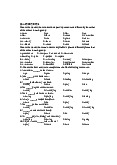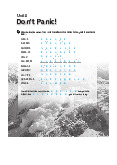



















Preview text:
LESSON PLAN I. General information
1. Teaching materials and equipment:
- Textbook: TIME ZONE 4, 3rd edition- Level: B1, Unit 5, page 60-63; - Handouts;
- Equipment: Projector or TV with large screen, Whiteboard, Student name tags, Wooden blocks to track teamwork performance.
2. Teaching context and target learners: - Length: 60 mitnues
- 14 teenagers aged 16-17 at grade 11at B1 level. These students come to this class because they want to get better result in their school work and get
an IELTS certificate in grade 12 so they can apply for universities. The term ‘student(s)’ (S) and ‘learner(s)’ used in this lesson plan refer to the same subjects.
- This is the first time the teacher (T) has taught the class, so she taught to their permanent teacher to understand about their ability and check if they
all have cell phones so the teacher can adjust the questions in the speaking follow-up activities, avoiding making them feel inferior for not having their own cell phones.
- The learners are basically divided into the strong learners and average learners. They have been taught about reading skills and strategy. 2. Learning outcomes:
By the end of the lesson, learners will be able to: -Language/knowledge:
+ Understand very basically about how iPhones are made and the global concept of identifying where an object (such as an iPhone) is made;
+ Recognize the vocabulary about the general and basic manufacturing process of making an iPhone (manufacturing, supply, combing, assembling, variety, global);
-Skills: By the end of this lesson, the learners will be able to:
+ Develop the reading skills through reading and answering different of reading questions (reading for main ideas/details, making inference and
reference) and explain their reasons to support their answers.
- Attitude: Learners are supposed to:
+ Use English during the class, even when asking for support;
+ Work individually and cooperatively in pair work and being supportive, not criticizing in their team;
+ Actively engage in-class activities. II/Lesson Plan: Stage Time Stage and Pattern of Teacher’s Activities Learners’ Activities Assessment aim interactio n PRE 6 min Lead-in T-S
Before the lesson begins, T asks the S to choose a S made their name T listens to their To active S-T
colour they prefer between green and yellow, then tags. answers and learners’
gives them the A-4 paper of the colour they have gives feedback. schemata
chosen to write their names on. After that T asks Ss Most possible about the
put their name tags at their desks and divide the answers are topic.
class into 2 teams according to the colour, let them encouraged. choose their teams’ names.
T gives each team 7 wooden blocks at the
beginning, explaining that their team will get a
wooden block and build them up for every answer
no matter that is a correct answer or wrong one. At
the end of the lesson, the team with higher wooden block is the winner.
Unit 5: How is the iPhone made?
T shows a 1-minute video about the design of S share their ideas. iPhone 15. Expected answers:
T invites S to answer the following questions: The video ‘s about 1. What ‘s the video about? mobile phone/cell
2. Can you guess our topic today? phones/ smart phones/technology, etc. WHIL 7 min Reading for T-S ACTIVITY 1 T walks around, E gist S-T T hands out the 2 book pages. observes S,
Notes about the photo: If S asks about the photo, T making sure
can explain the photo shows Tim Cook speaking at they are doing Apple event in 2019. their work and
T shows the 2 two book pages and draw students’ speaking
attention to the title, which is a question: ‘Where is English if they the iPhone made?’ discuss with their friends/team.
T has S read the 1st time in 3 minutes. T answers the T offers support
T asks S to skim the article and look at the map in 2 question. (but not tell
minutes to answer ‘Can you answer the question in Expected answers: them the
the article ‘Where is the iPhone made?’ easily?’ -Easy/Not easy with answers) if she
If S answer ‘easy’, ask them that what country is the names of the finds out S
and encourage other answers from the rest S. countries is/are struggling (USA/China/Japan with some parts etc.) and she knows -Difficult because that it is time to there are many offer support. countries. Reading for
T has S read the 2nd time in 2 minutes. S scan the article and details
T asks S to scan the article and underline all the underline the countries mentioned. countries mentioned.
Accommodation if needed: T tell S to scan for Expected answers:
capital letters because a country name USA, Germany, will begin with one. Switzerland, China, South Korea, Japan. A:15mi
ACTIVITY 2: Comprehension (page 62) n Reading for TASK A main idea
T has S read the 3rd time and do the task in 15 S read, write the Reading for
minutes. While they are reading, they should write notes, highlight or details
very short notes of the main idea of each paragraph. take notes if they Making need and answer the inference and questions with reference explanations and check their answers.
- T has S read the questions silently and circle the correct answers.
-After S have finished, T invites S to
share their answers. For each question, T
asks if any S have a different answer and
let S share their explanations before
concluding the final correct answer(s).
Answer keys: 1c, 2a, 3b, 4b, 5c S read, write the TASK B notes, highlight or take notes if they
T encourages S to answer questions in task B need and answer the
without having to read the text again. If S has to
read the text again to answer the question, use the questions with
main idea of each paragraph to know where to look explanations and
for the information. They are told that they have 10 check their answers. minutes for this task. B:10 min
Answer key: 1F, 2NG, 3F, 4NG, 5T
Accommodation for both task A and B:
T creates a list of 14 words of activity 2 &4 and
copies of these words with their definitions (the file
is attached in this lesson plan), then cuts each word
with its definition separately and packs in piles
from number 1 to 14, putting them upside down.
These words are the words that T predicts may
prevent S’s process of understanding the text. Each
S can come to ask for support with the words
among this list on the condition that their team will
lose a wooden block. The wooden block will be
removed from the third row from the top as Jenga
rule. T then will give them a piece of paper with this word and its definition.
T may paraphrase the questions, give S hints to
guess the meaning of some key words, and locate
the paragraph(s)/ group of sentences where S can find the answers. POST 6 min Speaking S-S ACTIVITY 3 S work in pairs, T walks around, Critial S-T
T has S work in pairs, ask and answer questions in ask and answer observes S, thinking skill
the attached handout. Student A asks and takes the questions in making sure
notes by circling the given answers or write. the handout. they are talking
Student B answers about themselves by using the 7 representatives about the
prompts or give their own ideas. Then Student B from 7 pairs handout in
asks and takes notes and Students A answers. report to class. English and
For each Q, T invites representative from each pair gives comments
to talk about their partners. The sets of Qs for each if needed while
representative to be reported are (1,2,3), 4,5 and are not disturbing
repeated until all 7 representatives report to the them. class. 11 min Reinforce T-S ACTIVITY 4 (page 62) vocabulary S-T A. S follow along, T walks around, read and answer observes S, the questions. making sure they are doing their work and speaking English if they discuss with
T has S find the bold words in the their
reading passage and highlight the words.
T has S circle the correct answers to friends/team. complete the sentences. T offers support (but not tell
Answer key: 1. difficult, 2. each part separately, 3. them the
provide, 4. mix them together, 5. Affects the whole answers) if she world, 6. many types. finds out S
Accommodation: T emphasize and give some hints is/are struggling
or emphasize some words that help the S guess the with some parts meaning of the words. and she knows that it is time to B. offer support. S follow along, read and answer the questions.
T has S use the correct expressions to complete the sentences.
T checks answers and briefly teach S to pronounce the keywords.
Answer key: 1. global network, 2. global awareness, S answer the Qs
3. global warming, 4. global brand. 5min with their Reinfore
Accommodation: T explains some key words in the global T-S
questions (e.g awareness, customers) that help the S explanations. understandin S-T
guess the meaning of the words. g WRAP UP T asks S:
1.Where is the iPhone made? Why do you say so?
2.Where is T’s computer made?
3.Is it easy to say where a product is made?
LIST OF NEW WORDS TO ACCOMODATE FOR THE WHILE STAGE:
1. head quarter 2. manufacturer 3. demand 4. replace 5. possible - impossible 6. product
7. supply chain 8. customer 9. solution 10. issue 11. main office 12. awareness 13. brand 14.recognize
1. head quarter (n): the place in a company where important decisions are made
2. manufacturer (n): a factory that makes or produces things
3. demand (n): the thing you want
4. replace (v): if we place A with B, that means we take B and get rid of A 5. possible (adj): can be done
impossible (adj): antonyms of possible, cannot be done
6. product (n): a finished thing
7. supply chain (n): a system from producing a product to delivering it
8. customer (n): a person who buys a product
9. solution (n): the way to deal with difficult things 10. issue (n): problem
11. main office (n): the place in a company where important decisions are made
12. awareness (n): when you have an awareness of something, you know and understand about it
13. brand (n): iPhone, Samsung, Coca-cola 14. recognize (v): to know




